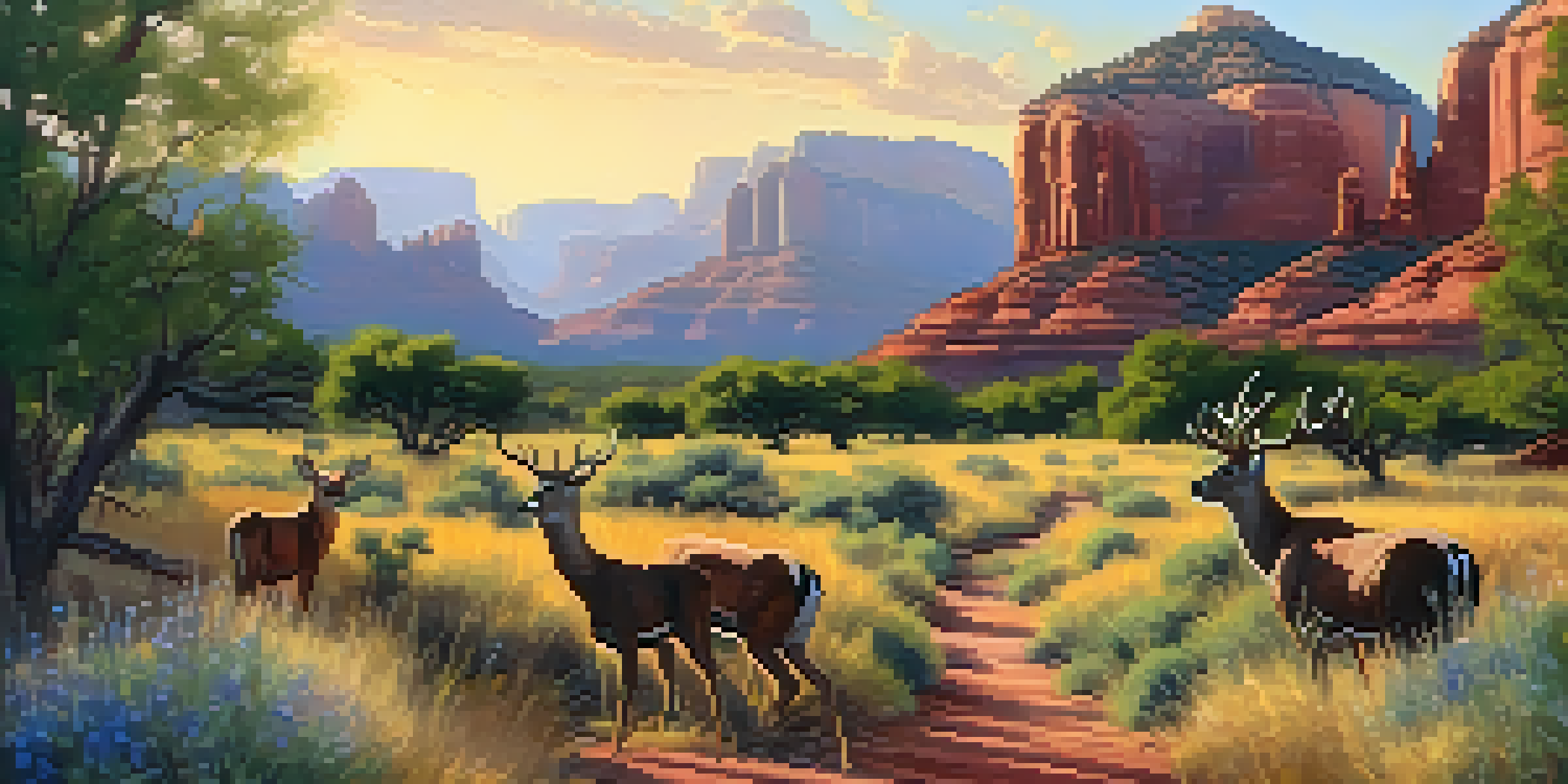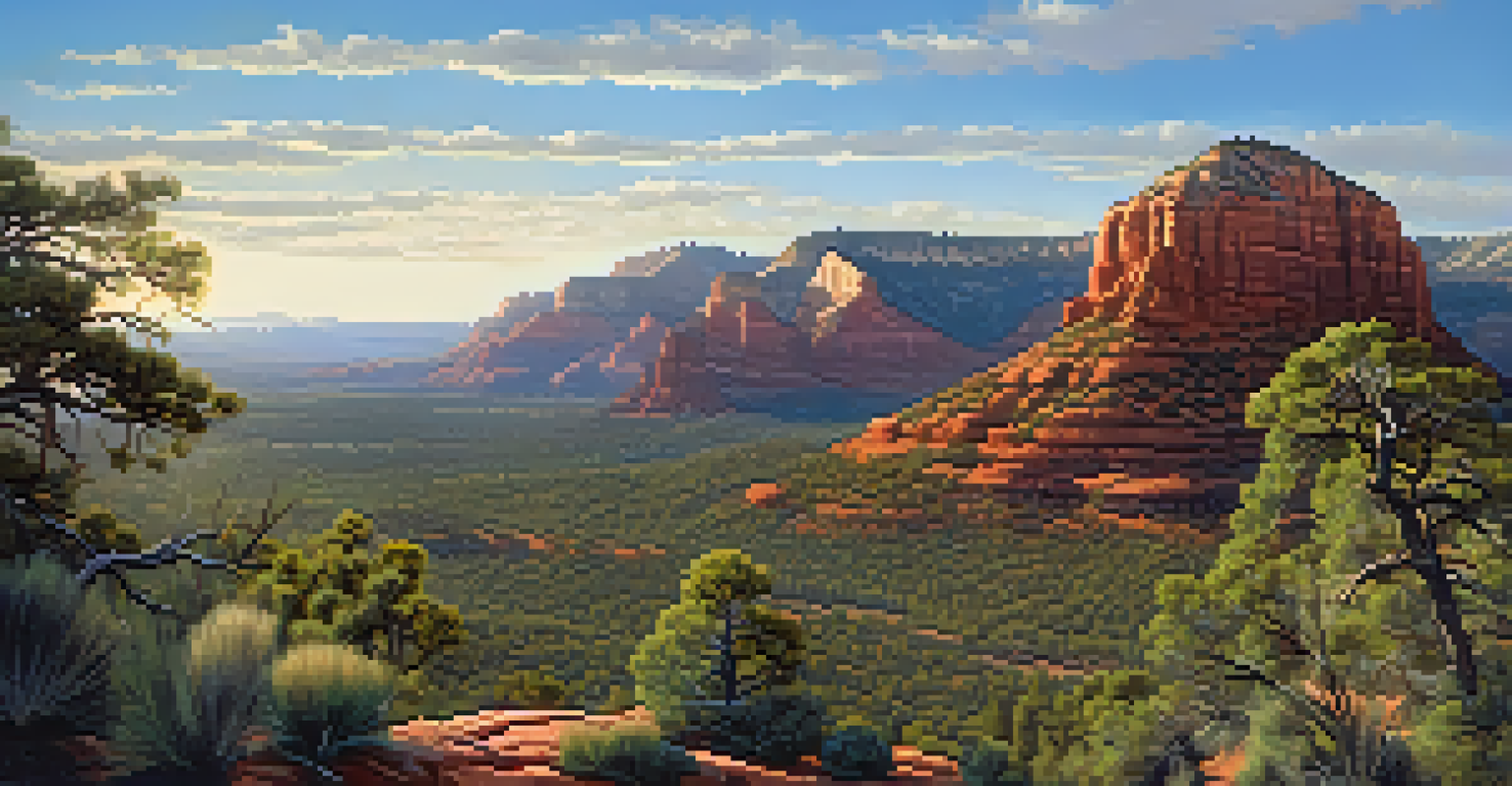Sedona's Wildlife Corridors: Connecting Habitats Together

Understanding Wildlife Corridors and Their Importance
Wildlife corridors are crucial pathways that connect fragmented habitats, allowing animals to move safely between different areas. Imagine these corridors as nature's highways, where wildlife can travel without the risks posed by roads and human developments. They help maintain genetic diversity, which is essential for the health of animal populations.
The future will be shaped by how we care for our natural environment today.
In Sedona, these corridors play a vital role in sustaining local ecosystems. With diverse species ranging from deer to coyotes, creating connections between habitats ensures that animals can find food, mates, and shelter. This connectivity not only supports wildlife but also enhances the overall health of the environment.
As urban development continues to expand, preserving and enhancing these corridors becomes increasingly important. Without them, isolated populations may struggle to survive, leading to a decline in biodiversity. Understanding their importance is the first step toward protecting Sedona's unique wildlife.
The Unique Ecosystem of Sedona
Sedona is renowned for its stunning red rock formations and vibrant landscapes, but its diverse ecosystems are equally impressive. From lush forests to arid deserts, these environments are home to a variety of wildlife, each adapted to thrive in their specific habitat. This diversity makes Sedona a critical area for wildlife conservation efforts.

One of the most notable aspects of Sedona's ecosystem is its elevation range, which allows for different vegetation types and animal species. For instance, higher elevations support ponderosa pine forests, while lower areas feature chaparral and desert scrub. This variation creates a mosaic of habitats that wildlife depends on for survival.
Wildlife Corridors are Essential
These corridors connect fragmented habitats, allowing safe movement for wildlife and maintaining genetic diversity.
However, as development encroaches on these natural areas, it threatens the delicate balance of Sedona's ecosystems. Preserving wildlife corridors is essential to ensure that these habitats remain connected, allowing animals to navigate the landscape freely and safely.
Challenges Facing Sedona's Wildlife Corridors
Despite their importance, Sedona's wildlife corridors face numerous challenges. Urbanization, road construction, and recreational activities can fragment these pathways, making it difficult for animals to traverse their natural routes. This fragmentation can lead to increased mortality rates, as wildlife often find themselves crossing busy roads.
In every walk with nature one receives far more than he seeks.
Climate change also poses a significant threat to these corridors. As temperatures rise and weather patterns shift, wildlife may need to migrate to find suitable habitats. If these corridors are not preserved, animals may struggle to adapt to changing conditions, leading to further population decline.
Community awareness and involvement are crucial in addressing these challenges. By understanding the importance of wildlife corridors, residents and visitors can advocate for conservation efforts that protect these vital connections, ensuring that Sedona's wildlife can thrive for generations to come.
The Role of Local Organizations in Conservation
Local organizations play a pivotal role in the conservation of Sedona's wildlife corridors. Groups such as the Red Rock National Conservation Area and the Arizona Game and Fish Department work tirelessly to monitor wildlife populations and promote habitat connectivity. Their efforts are essential in understanding how to best protect these corridors.
These organizations often collaborate with community members, offering educational programs and volunteer opportunities. Through initiatives like clean-up days and habitat restoration projects, residents can actively contribute to the preservation of Sedona's natural landscapes. This community involvement fosters a sense of stewardship and connection to the environment.
Community Involvement is Key
Local residents can support conservation efforts by participating in initiatives and spreading awareness about wildlife corridors.
Moreover, these organizations conduct research to identify critical areas that need protection and restoration. By utilizing data-driven approaches, they can effectively advocate for policies that prioritize wildlife corridors, ensuring that these essential pathways remain intact for future generations.
How Wildlife Corridors Benefit Humans
While the primary focus of wildlife corridors is on animal movement, they offer significant benefits to humans as well. Healthy ecosystems provide clean air, water, and soil, all of which are vital for our well-being. By supporting wildlife corridors, we indirectly support the health of the environment that sustains us.
Additionally, wildlife corridors enhance recreational opportunities. Nature enthusiasts can enjoy hiking, bird watching, and wildlife photography in areas where animals thrive. This connection to nature not only enriches our lives but also supports local economies that rely on tourism.
Moreover, having diverse wildlife in our surroundings can foster a greater appreciation for nature. It encourages us to learn about local species and their habitats, deepening our understanding of the environment. This awareness can lead to stronger advocacy for conservation efforts, benefiting both wildlife and the community.
Community Engagement: How You Can Help
Community engagement is vital in the effort to protect Sedona's wildlife corridors. Residents can participate in local conservation initiatives, whether through volunteering for habitat restoration projects or attending educational workshops. Every small action contributes to the larger goal of preserving these essential pathways.
Additionally, spreading awareness about the importance of wildlife corridors can inspire others to take action. Sharing information on social media, discussing the topic with friends and family, or even writing to local representatives can make a significant impact. The more people understand the value of these corridors, the more support there will be for conservation efforts.
Future Depends on Conservation Efforts
Innovative solutions and collaboration among organizations, community members, and policymakers are vital for preserving Sedona's wildlife corridors.
Lastly, being mindful of our own actions while enjoying Sedona's natural beauty can help protect wildlife. Simple practices like staying on designated trails, respecting wildlife habitats, and reducing waste can make a big difference. By being responsible stewards of the land, we can ensure that Sedona remains a thriving habitat for both wildlife and humans.
The Future of Sedona's Wildlife Corridors
Looking ahead, the future of Sedona's wildlife corridors hinges on our commitment to conservation. With ongoing development pressures, it is crucial to prioritize habitat connectivity and implement strategies that protect these vital pathways. The collaborative efforts of local organizations, community members, and policymakers will play a significant role in shaping this future.
Innovative solutions, such as wildlife overpasses or underpasses, can help mitigate the impact of roads on animal movement. By creating safe passages for wildlife, we can reduce roadkill incidents and promote healthy populations. These engineering marvels not only protect animals but also enhance the overall integrity of Sedona's ecosystems.

Ultimately, the preservation of wildlife corridors in Sedona is a shared responsibility. By fostering a culture of conservation and engaging the community, we can ensure that future generations will enjoy the rich biodiversity that makes Sedona so special. Together, we can create a landscape where both wildlife and humans coexist harmoniously.